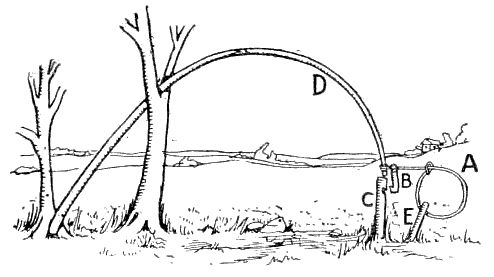How To Make Twitch Up Snare

A twitch up is a flexible sapling, which, when bent over and secured with a triggering device, will provide power to a variety of snares. Select a hardwood sapling along the trail. Pine is more likely to break and isn't going to be as forceful. A twitch-up will work much faster and with more force if you remove all the branches and foliage.
When making a twitch up snare set you can use a sapling where it is found as your spring (D) or use a cut sapling with its base secured, stuck, or wedged securely to a spot.
The snare is tied to the end of the sapling. A trigger (B) is made that holds the sapling down in a cocked position. The trigger can be easily dislodged and release the sapling to spring upwards. This occures when the animal pulls on the snare as it moves away.
This is a very effective method for utilizing a snare. The success rate of a twitch up snare is much higher than a stand-alone simple snare because the sapling will spring up and tighten the snare with force and it then uses the weight of the animal to hold and tighten the snare. This usually kills the animal quickly if the snare is around the animal's neck. This greatly aids in preventing the animal from eventually working out of the snare.
The trigger is the key to a great snare. The trigger can be as simple as a J shaped piece of wood. Cut a notch in a stake or tree trunk such that the has a slight upward cut. Another small piece of wood is whittled to a hook shape. The snare trigger is tied to the wire close to the sapling. The sapling is bent over and tries to pull the trigger upwards but it is set in the notch of the stake which prevents it from being pulled upwards.
When an animal pulls on the snare it pulls the trigger sideways to the stake, not upwards. This dislodges the trigger easily and the sapling springs upwards catching the animal securely.
